A flock of peacocks flew into the bushes as we alighted from
our car. Samhith grabbed my camera and followed, trying to capture them on
film, while I followed a little more slowly. As the narrow path widened, I
caught my first glimpse of the temples of Kiradu.
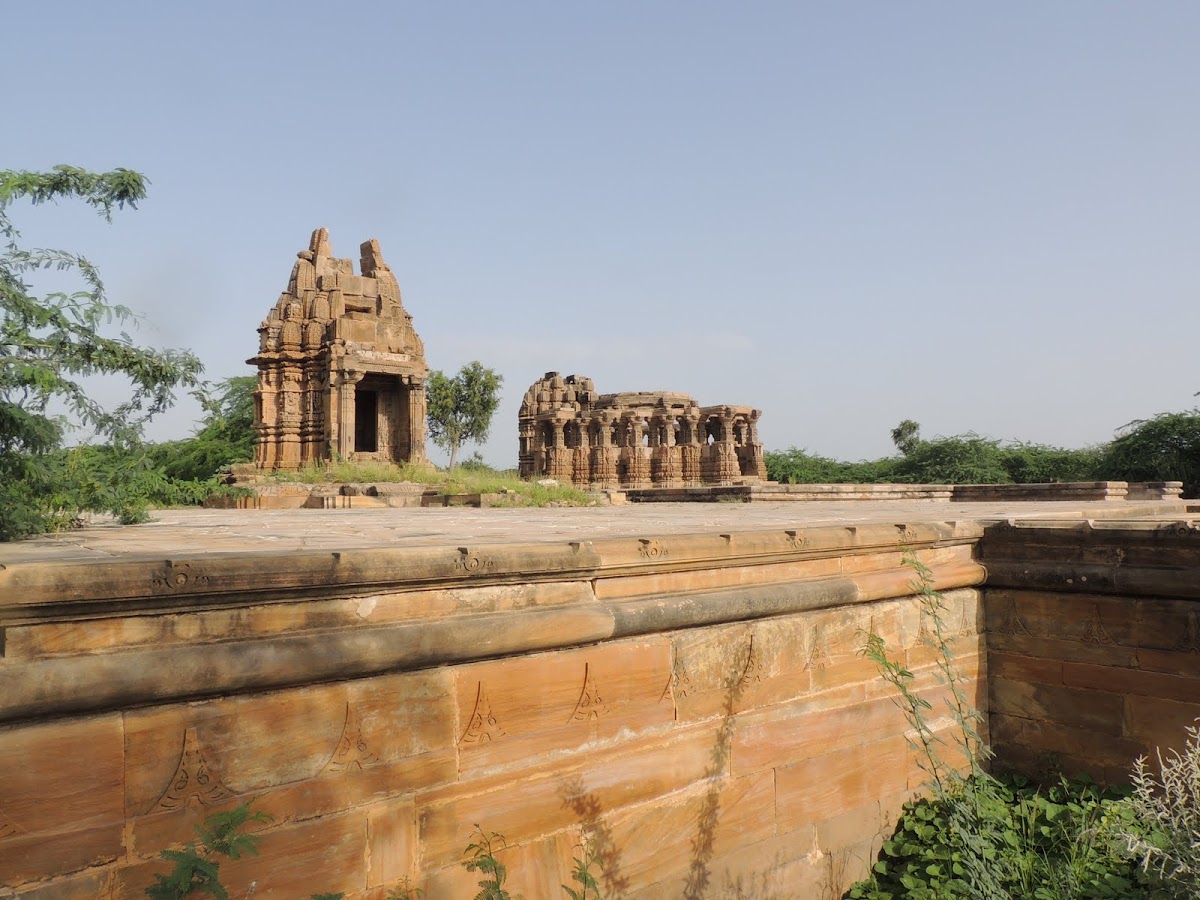 |
| One of the Shiva Temples in the front, and the Someshwara Temple seen behind... built on massive platforms. Our first glimpse of the temples of Kiradu |
There was no guide available, and in fact, we were the only
visitors that day. Sunil from
Suryagarh was our unofficial guide, but I
listened to his stories of Kiradu with only half an ear, for my attention was
captured by the temples themselves, and their stunning sculptures. Forgetting the camera, I stood, transfixed, at the centre of
the
mandapa at the Someshwara temple, looking around me in astonishment, at the
sheer number and detail of the carvings. Sunil must have sensed my complete immersion in the stone
images, for he abandoned his narrative of the famed curse of Kiradu, and looked
on, amused, as I went from pillar to pillar, trying to identify the figures
depicted on them.
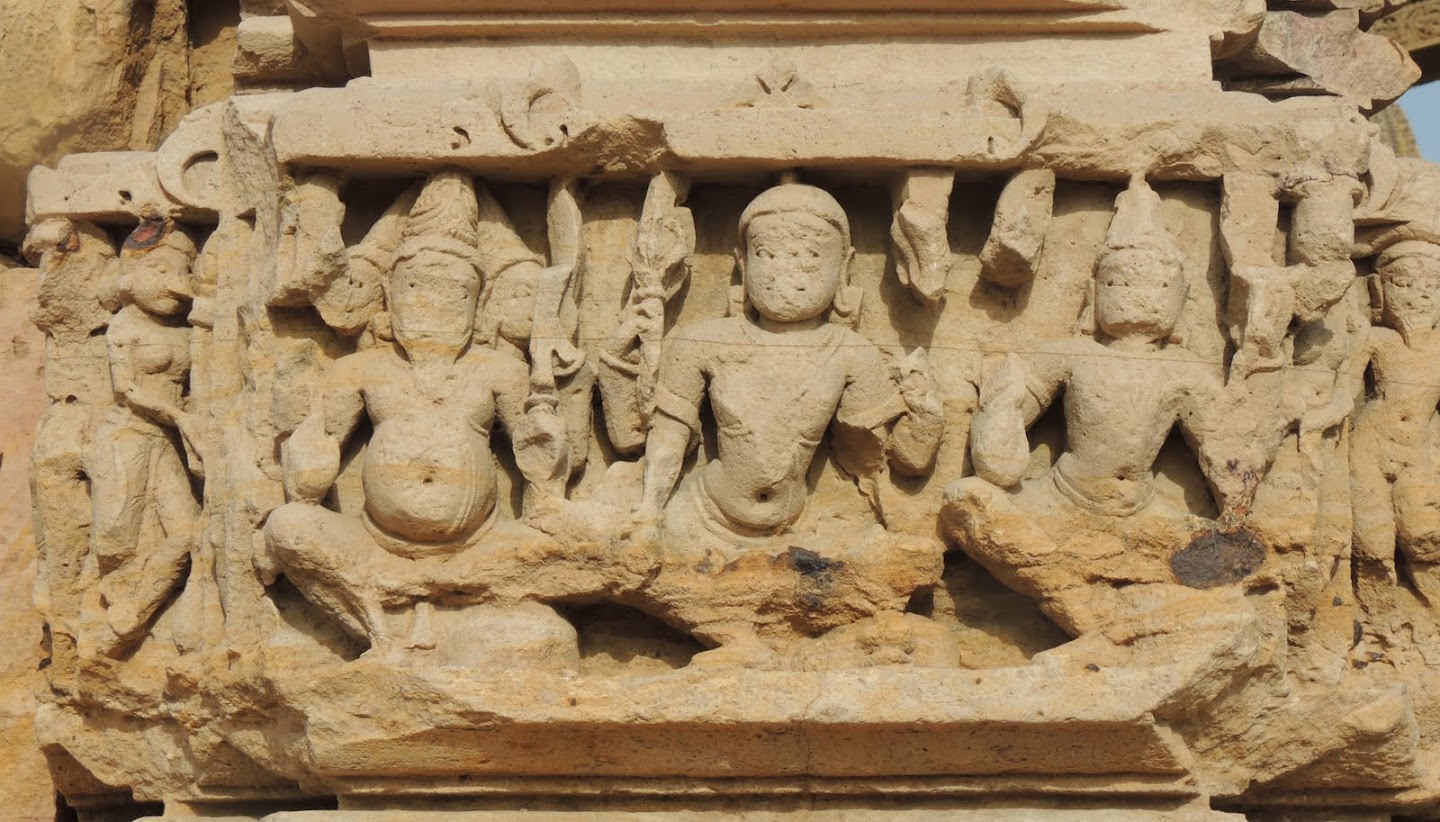 |
| A panel depicting the trinity of Brahma, Shiva and Vishnu at the entrance of the Someshwara Temple |
It was late afternoon, and sunlight fell beautifully on the
sandstone, lighting it up perfectly for photography. Belatedly realizing that I
was here not just to admire, but also write about these temples, I hurriedly
reclaimed the camera from Samhith, who was by then trying to photograph other
birds along with the peacocks. I had no eyes for birds, for the
temples occupied my full attention!
The temples of Kiradu, (located about 35 Km from Barmer and 180
Km from Jaisalmer) are believed to have been built during the 11th
to 12th centuries, by the Paramara rulers of the region, who were
feudatories of the Chalukyas of Gujarat (also called the Solanki Rajputs). It
is said that there were once 108 temples in this complex, but only 5 remain now.
The biggest, and best preserved temple here today is the
Someshwara temple, dedicated to Lord Shiva, and named for the king who ruled
around A.D.1161, according to an inscription. Kiradu was then known as
Kiratakupa, and was the capital of the Paramaras. It is also believed that this
is an ancient site, associated with the Kiratas (a hunting tribe) mentioned in
the Mahabharata.
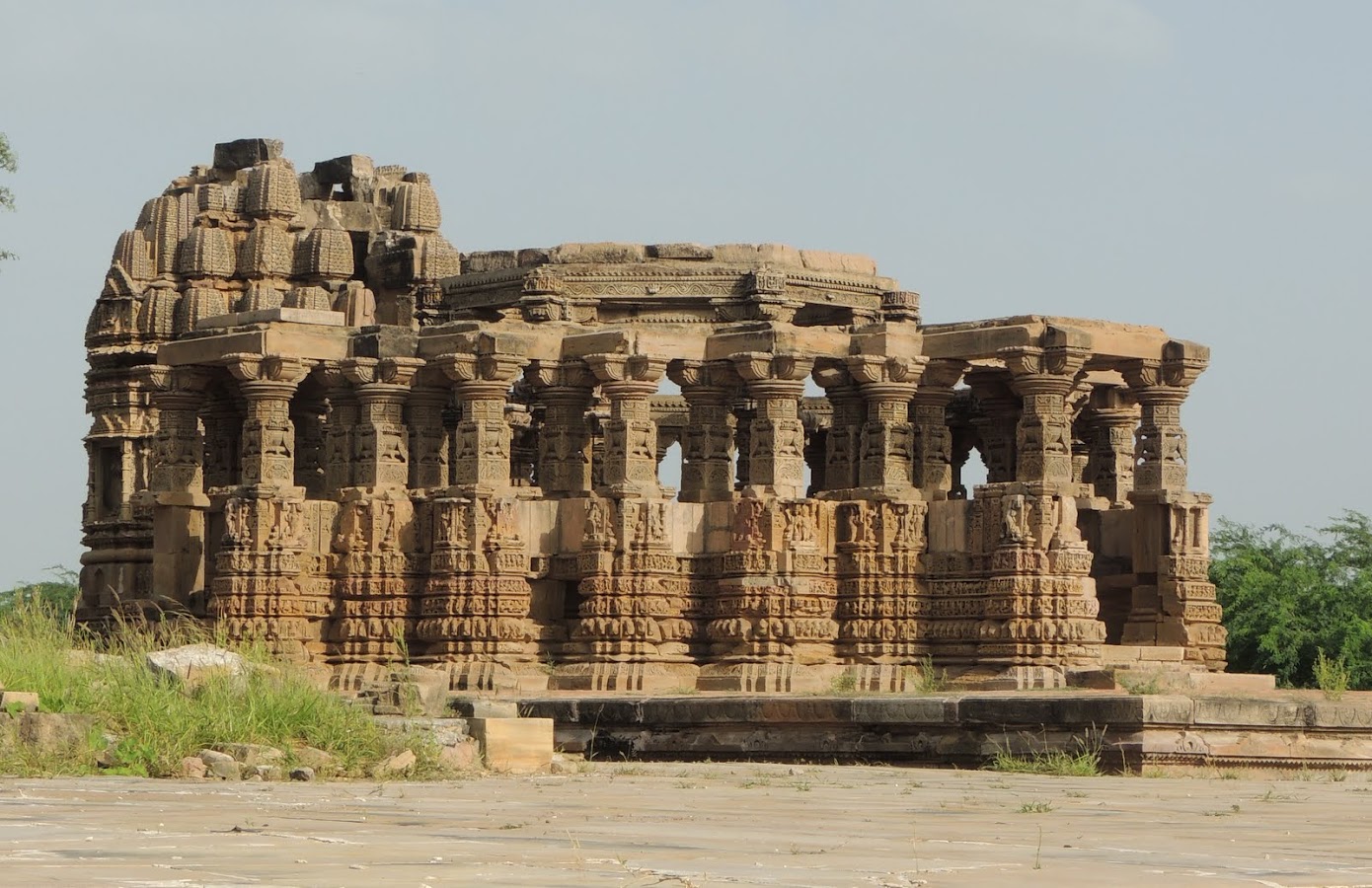 |
| Someshwara Temple, Kiradu |
Among the five temples, four are dedicated to Shiva, and one to
Vishnu. Architecturally, these temples mark the beginning of the Maru-Gurjara
style of architecture, which is a fusion of the earlier styles prevalent in the
desert state of Rajasthan (called Marusthala), and Gujarat
(Gurjara).
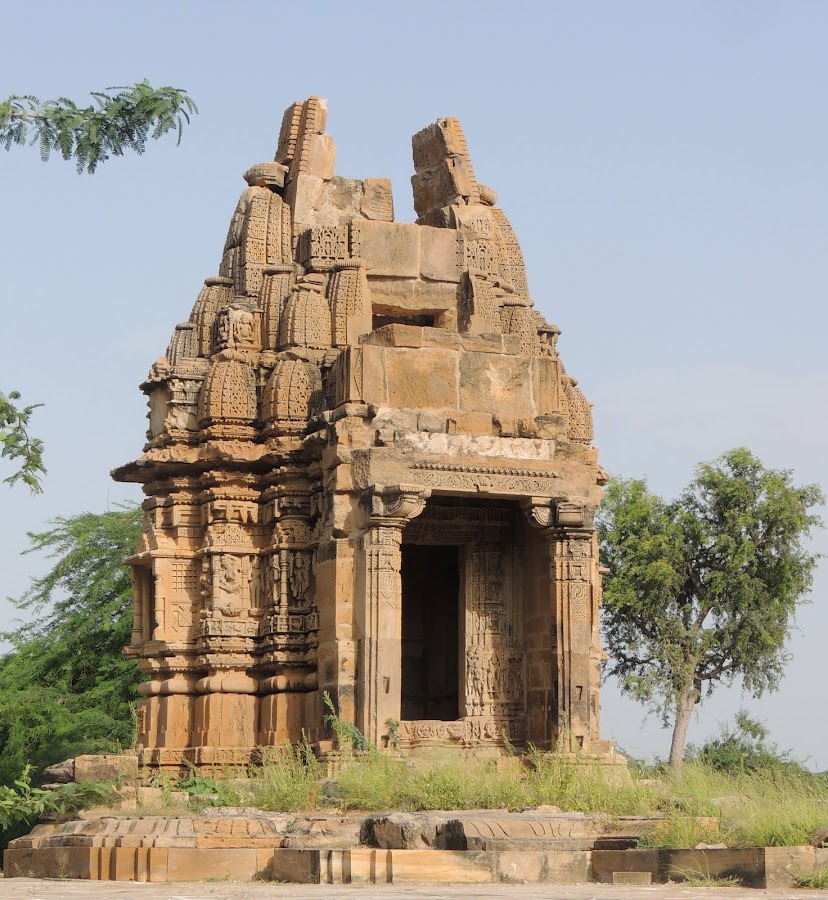 |
| One of the smaller Shiva Temples |
The two biggest temples – the Someshwara Temple, and the one to
Vishnu, both have octagonal Mandapas. At the Someshwara Temple, the lower
halves of these pillars are square and bare of sculptures, with only a hint
here and there of the intricacy they once might have borne. The upper halves
however, bear a wealth of figures…. Of different forms of the gods, Brahma,
Vishnu and Shiva, both, alone as well as with their consorts, the Matrikas, the
Dikpalas, and even sages.
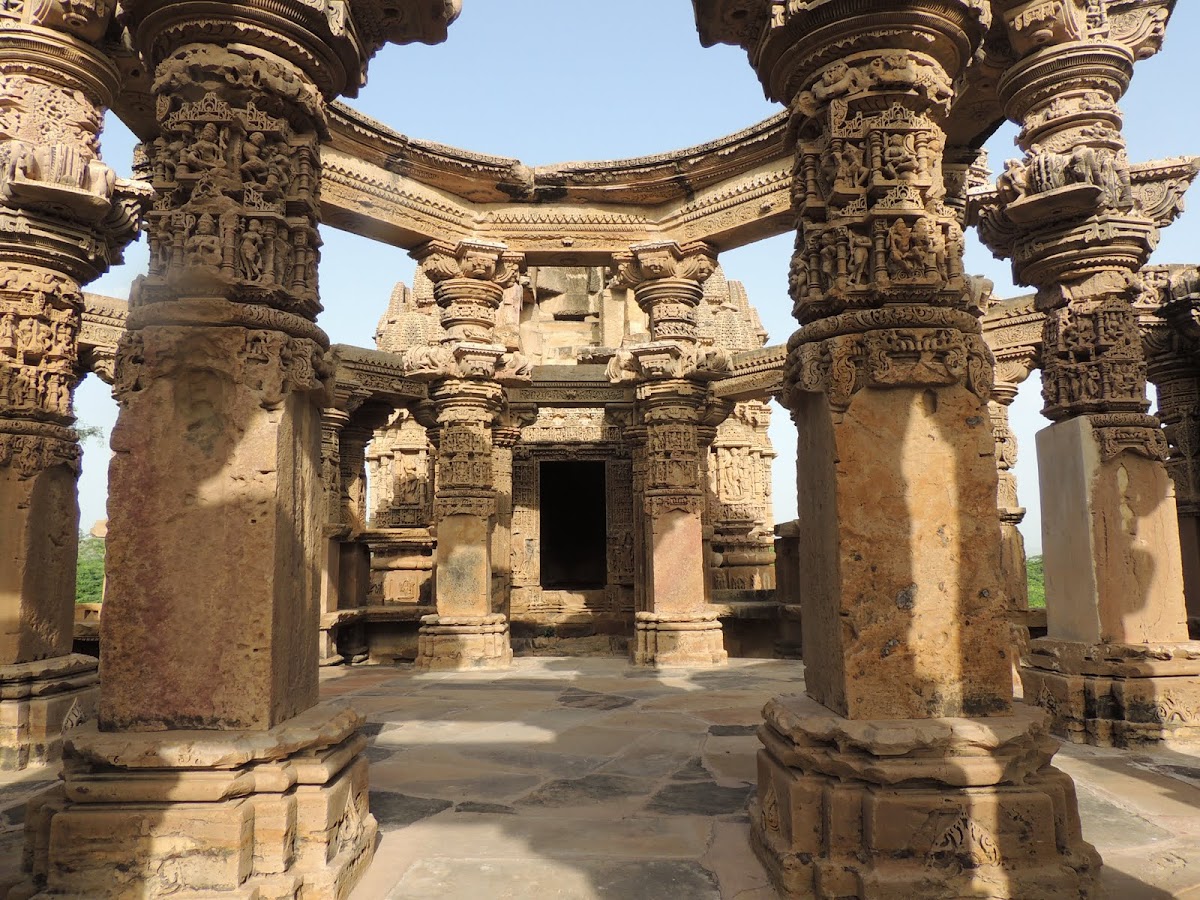 |
| The Octagonal Mandapa of the Someshwara Temple |
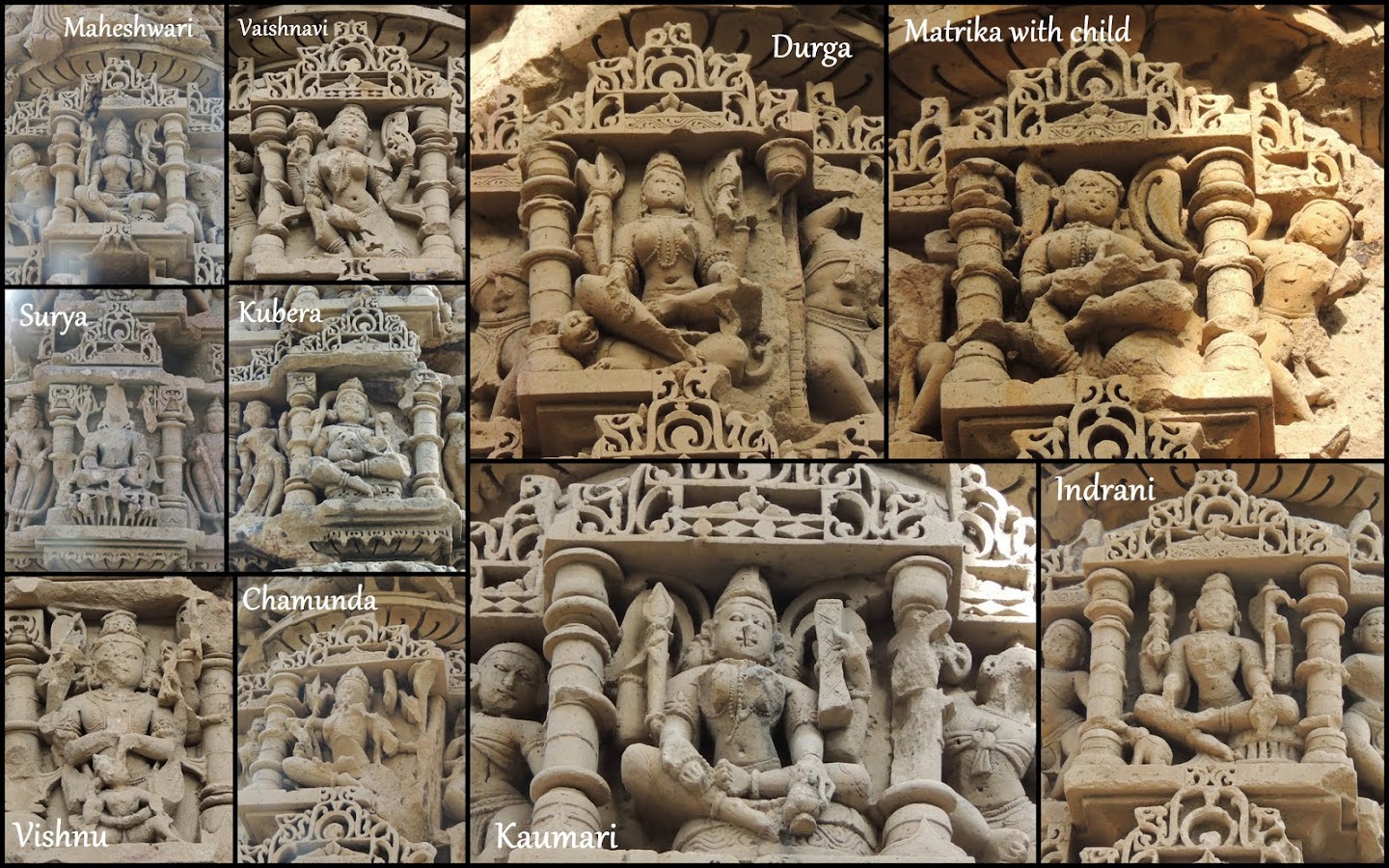 |
| Some of the deities depicted on the pillars of the mandapa at the Someshwara Temple |
The pillars at the Vishnu temple, on the other hand, are octagonal
in shape, and are profusely carved all over, with figures of dancing women at
the lower level, followed by Matrikas and different forms of the gods, as well
as Dikpalas. Above them are the heavenly beings, the Vidyadharas, and then a
row of Kiritamukhas. Above the pillars
are Makaras, from which emerge arches, which add to the decorative element of
the Mandapa, apart from the practical purpose of adding support to the roof!
Sadly, only two of such arches remain, and nothing remains of the roof itself.
 |
| The sole Vishnu Temple at Kiradu, with its octagonal Mandapa in front |
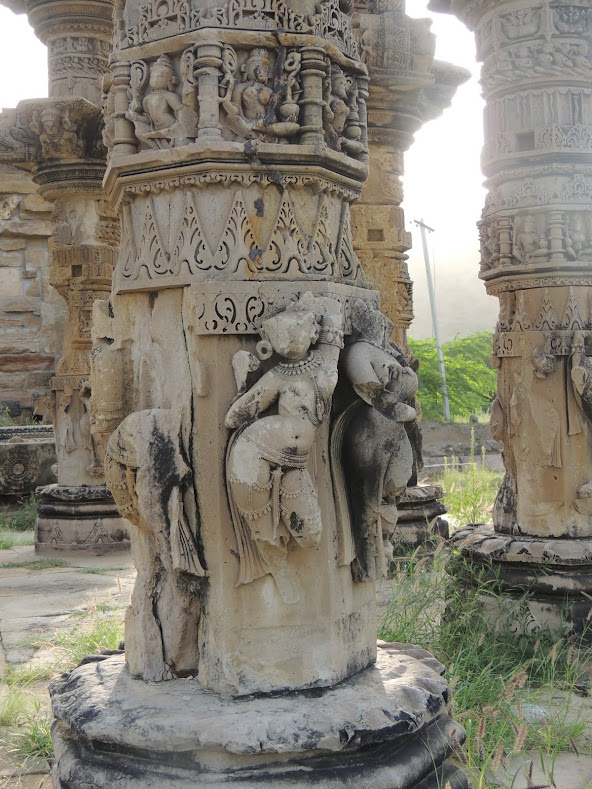 |
| The Octagonal pillars of the Mandapa, with beautiful women carved at the lowest level |
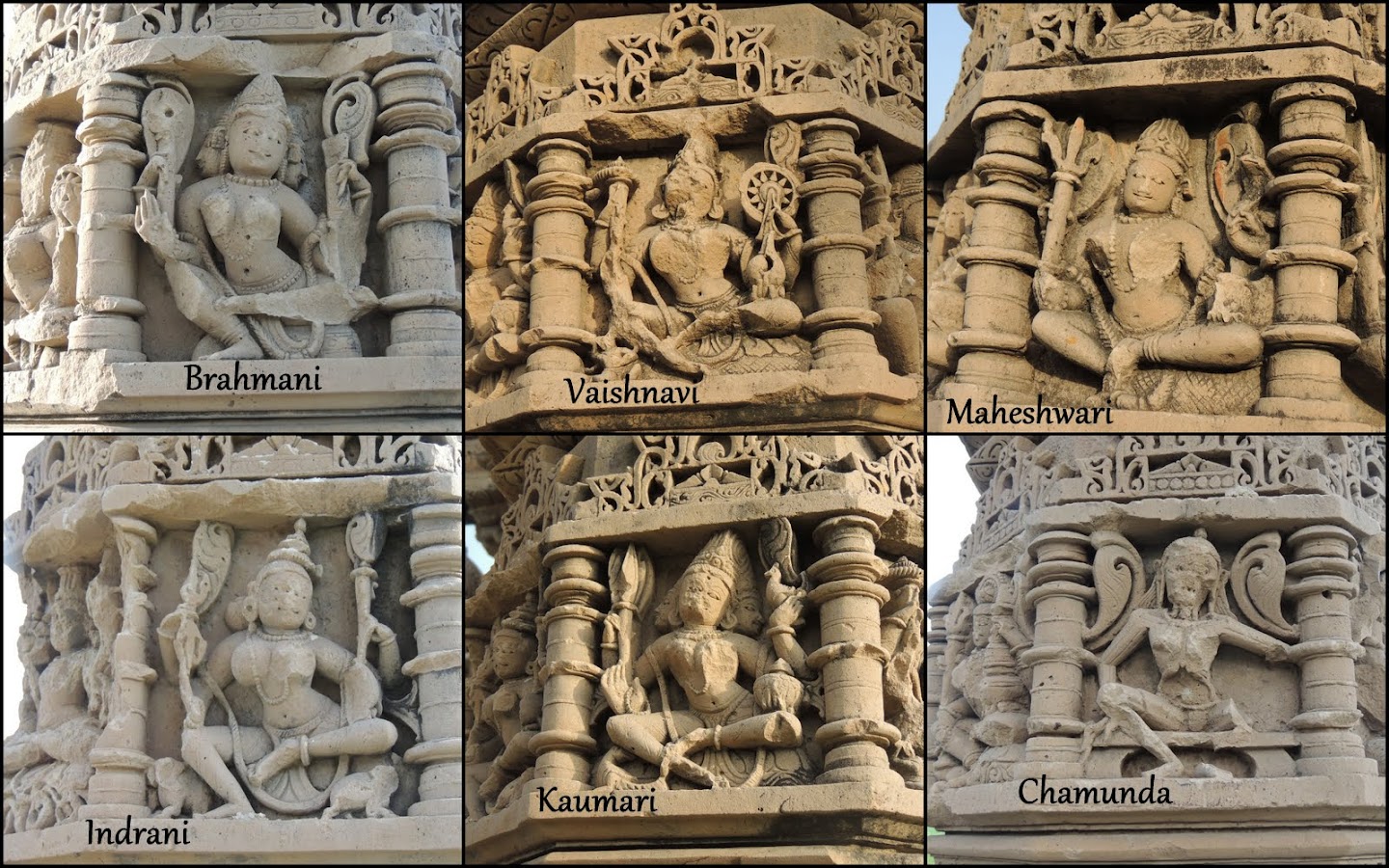 |
| Matrikas depicted on the pillars |
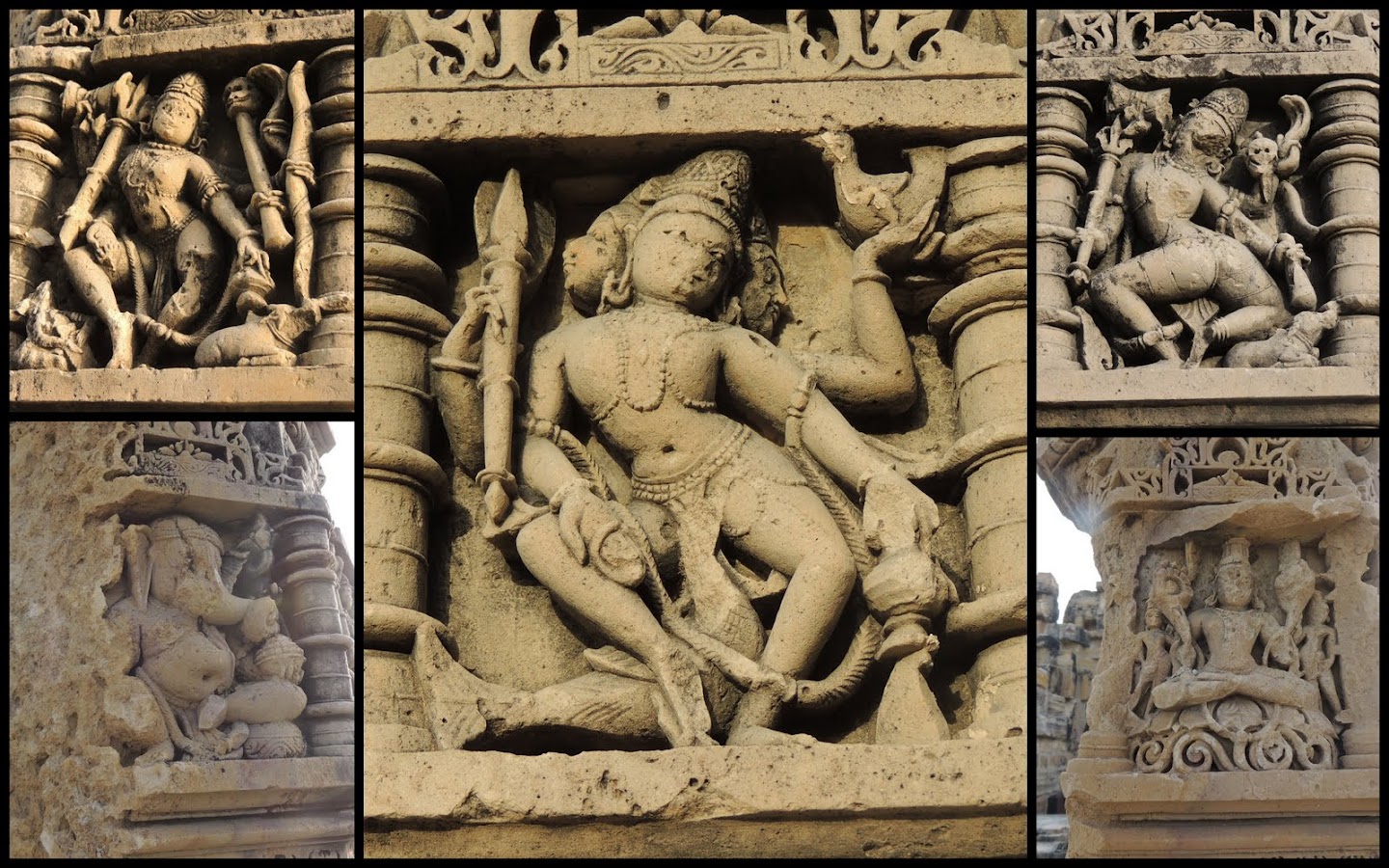 |
| Other deities depicted on the pillars - Kartikeya at the centre, Dancing Shiva on the top sides, Ganesha and Surya at the bottom. |
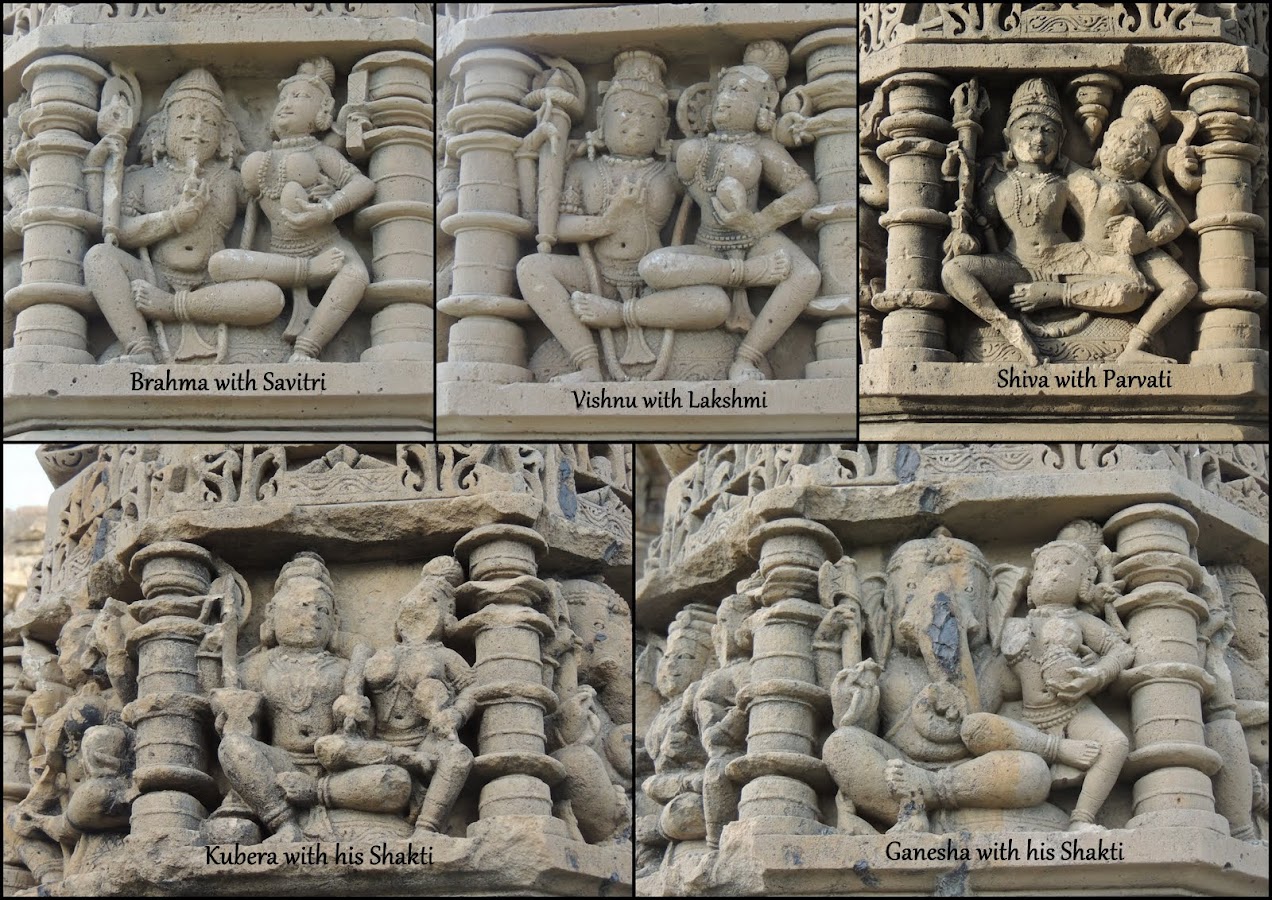 |
| Deities depicted with their consorts on the pillars |
 |
| The top portions of the pillars, with Vidyadharas and Kiritamukhas |
 |
| One of the two remaining arches over the pillars |
Coming to the main shrine, no idols stand in them, and we only
know that they were Shiva / Vishnu temples from the lintels, and inscriptions. The
door frames themselves are intricately carved, with some very interesting
features.
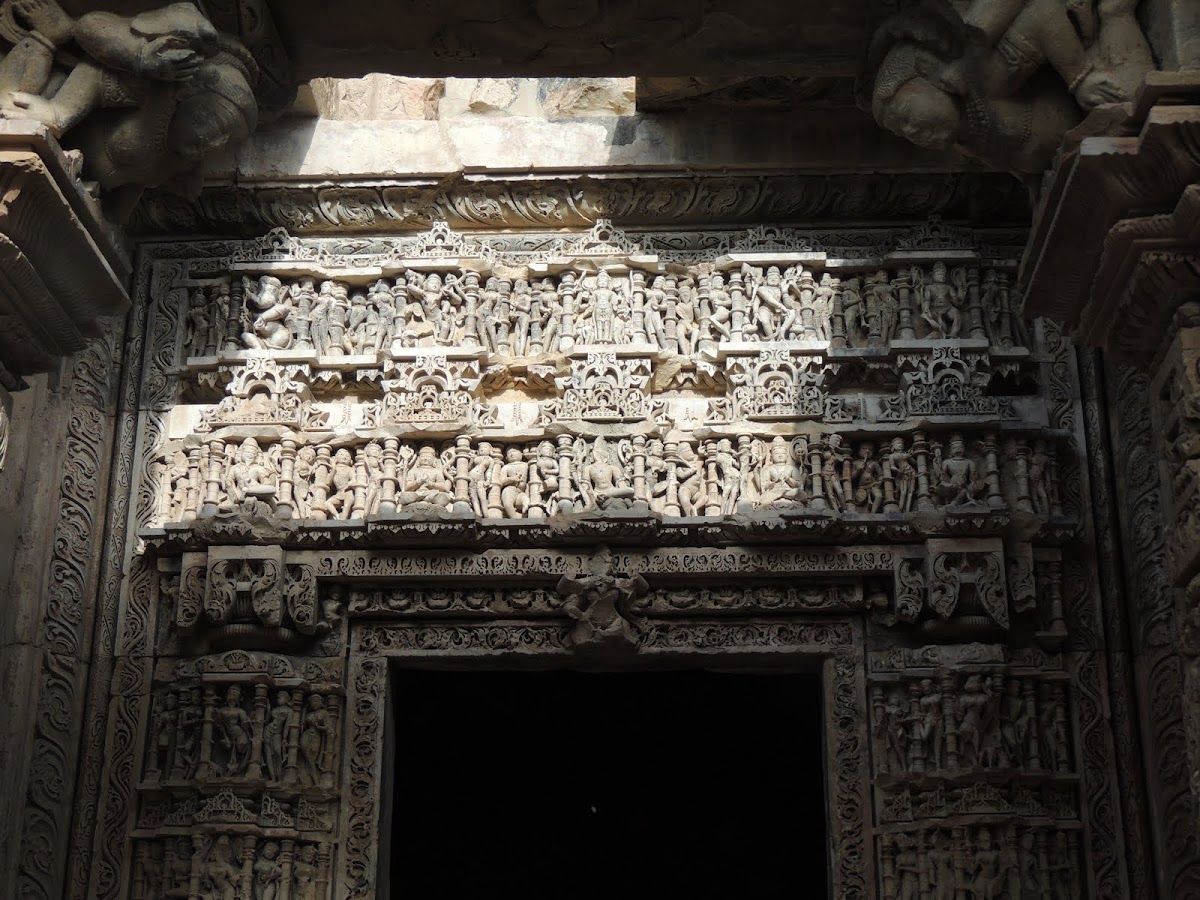 |
| The lintel of the main shrine at the Someshwara Temple |
At the Someshwara Temple, the lintel is carved in two levels,
with a variety of images, including Brahma, Vishnu, Ganesha, Kartikeya, and
multiple forms of Shiva, indicating that this shrine would have once housed a
Shiva Linga.
 |
| Some of the deities on the lintel of the Someshwara Temple |
It is very interesting to note that the central image on the
upper level of the lintel is a composite figure, combining the aspects of
Shiva, Vishnu, Brahma and Surya, or Hari-Hara-Pitamaha-Surya, similar to
what we had seen at Khajuraho!
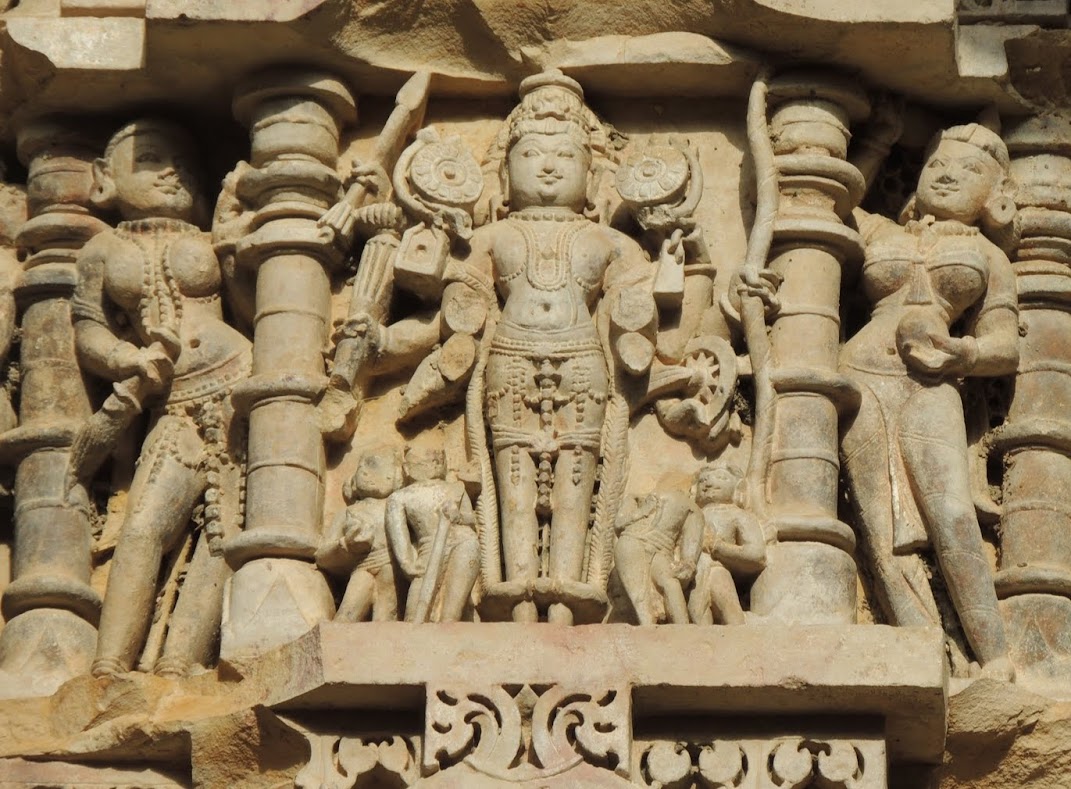 |
| Hari-Hara-Pitamaha-Surya - the central figure on the lintel of the Someshwara Temple |
The door frames, very interestingly, depict 6 deities, three on
either side. These include Ganesha and 5 Matrikas, among whom, Varahi, Indrani and Chamunda are recognizable.
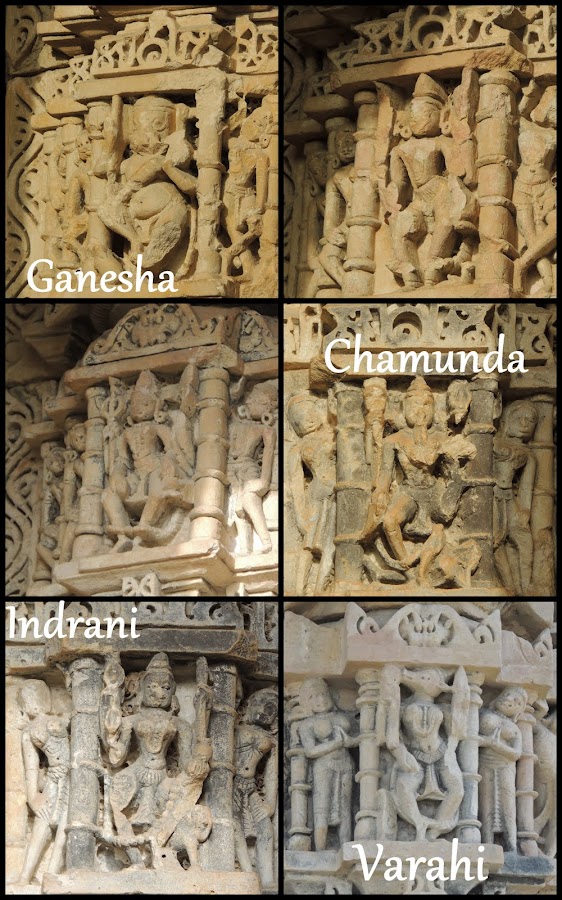 |
| Figures on the doorframes of the temples... Ganesha along with 5 matrikas |
At all the three smaller Shiva temples, the two layered lintel
includes images of Ganesha, and Kubera, along with Brahma, Vishnu and Shiva, 5
female deities or Matrikas, and the Navagrahas. The five Matrikas appear on the
doorframes as well, along with Ganesha.
 |
| Lintel of one of the smaller Shiva Temples... On the top level are five matrikas, with the Navagrahas between them, and on the lower level are Brahma, Ganesha, Shiva, Kubera and Vishnu, with sages between them. |
It was very interesting to see this repeated appearance of five
Matrikas with Ganesha. I have seen the Saptamatrikas with Ganesha and
Virabhadra, but never as a group of five.
Walking around the temples, trying to identify the different
images, I was repeatedly reminded of Khajuraho, especially since I could now
identify the
Ashta Dikpalas facing their particular directions on the outer
walls of all the temples.
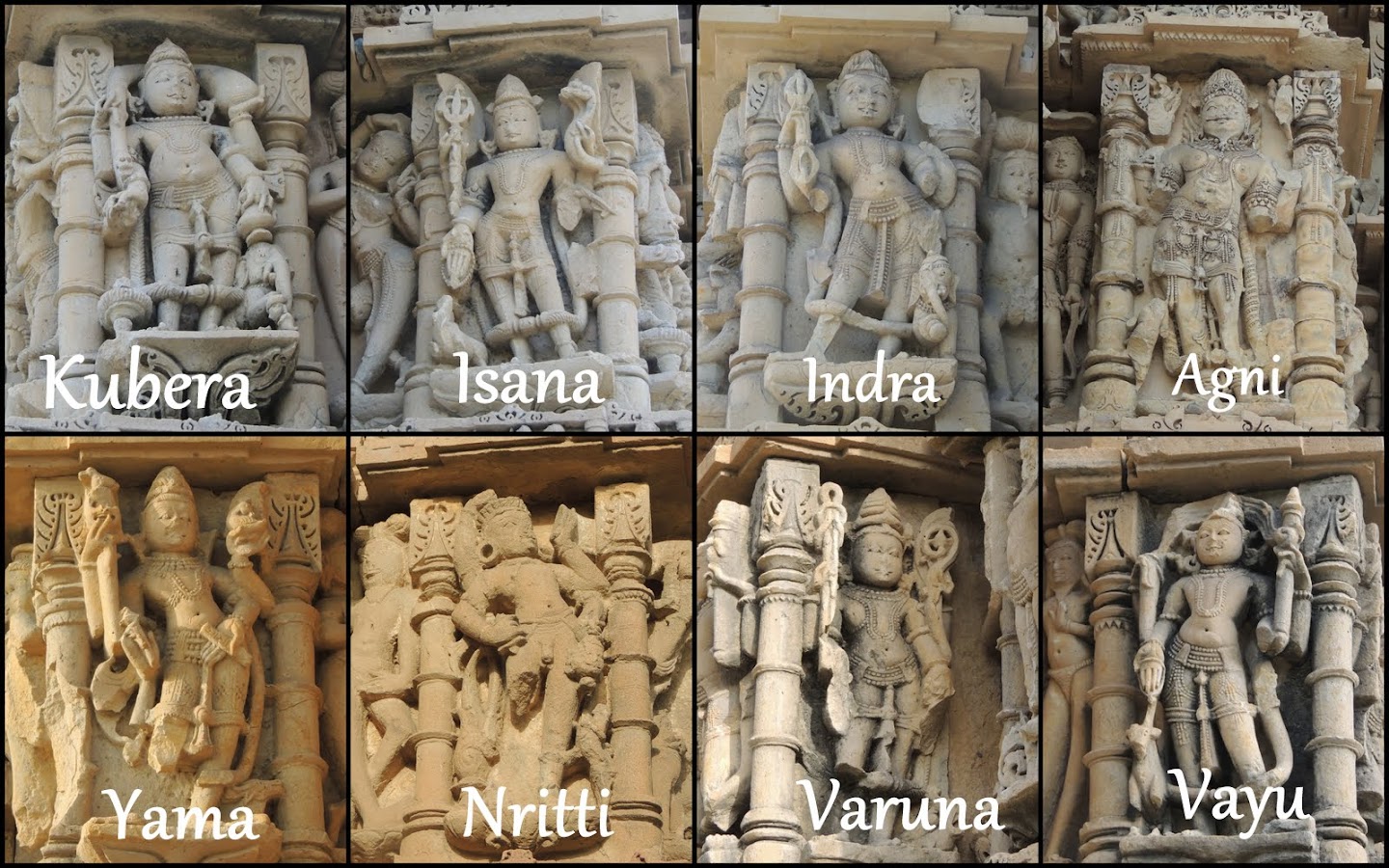 |
| Ashta Dikpalas, or guardians of the eight directions, seen on the outer walls of the temples |
The placement of the sculptures also reminded me of Khajuraho,
for example, each deity is flanked by Apsaras or Surasundaris, and Vyalas or
mythical creatures.
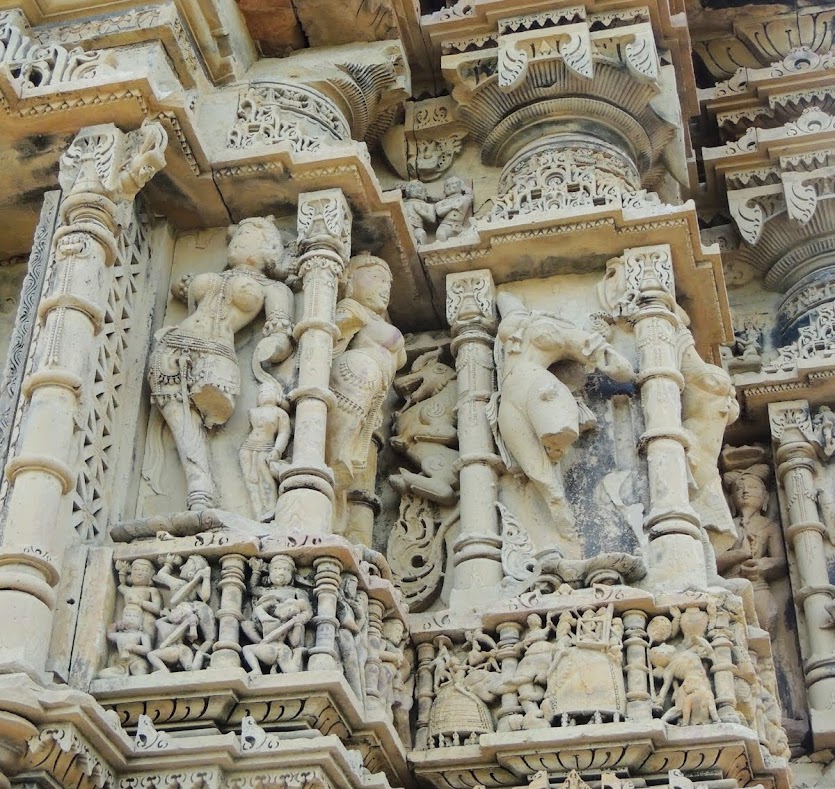 |
| Apsaras and deities, along with the Vyalas or mythical creatures, on the outer walls of the Someshwara Temple. Note the intricate panels below them, depicting other scenes. |
At some of the temples, along with the Vyalas, there are also what appear to be sages or holy men...
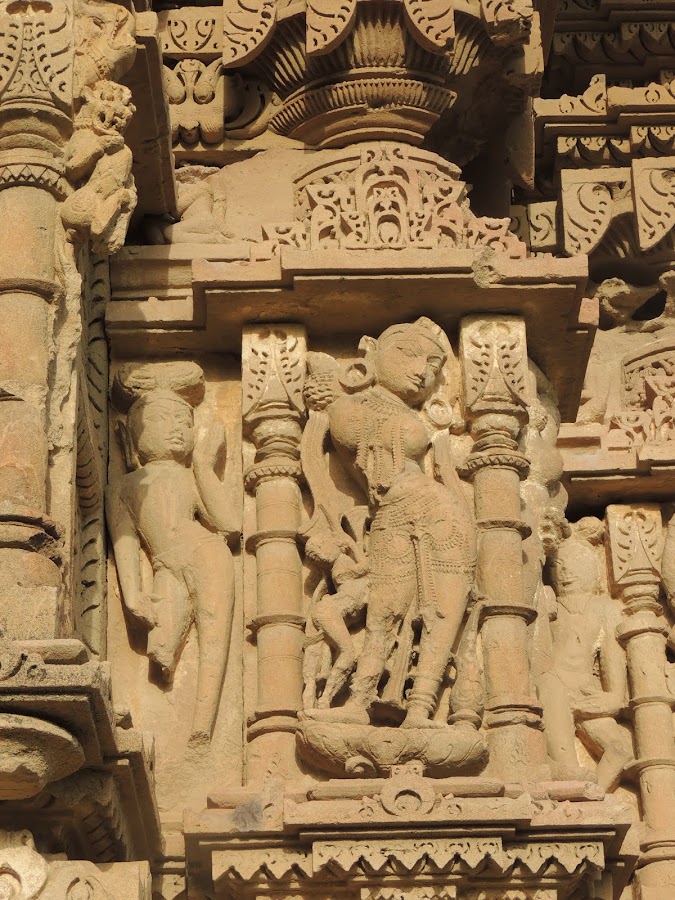 |
| An Apsara or Surasundari, with two sages flanking her |
There are also multiple levels of sculptures, including erotic
ones which are unobtrusively placed among the smaller carvings, as well as
secular scenes, depicting people as well as scenes and wars, from epics and
myths.
 |
| One of the most beautiful Apsara, or Surasundaris, shown washing her hair, at the Vishnu Temple |
 |
| Miscellaneous panels from the outer walls of the temples.... From top left, clockwise... the Sagar Manthan, or churning of the ocean, with Ganesha leading the gods!; the Navagrahas, someone tying a bunch of ropes, a group of sages tying their hair, and above them, people carrying animals, probably trophies of a hunt, and finally, a group of people hunting boars. Reminds me of Asterix! |
No wonder these temples are compared to the ones at Khajuraho. However,
while there indeed is a superficial resemblance, these temples mark a different
stage in the development of the architectural style, and deserve to be
recognized and appreciated as such.
It was also very interesting to notice the different manner in which
deities were depicted. The Dikpalas are large in size and easily visible on the
outer walls of the temples, and are also seen on the pillars and higher niches
of the spires. The Matrikas are smaller in size, but depicted in great detail.
We also see the gods with their consorts on the pillars and in the niches.
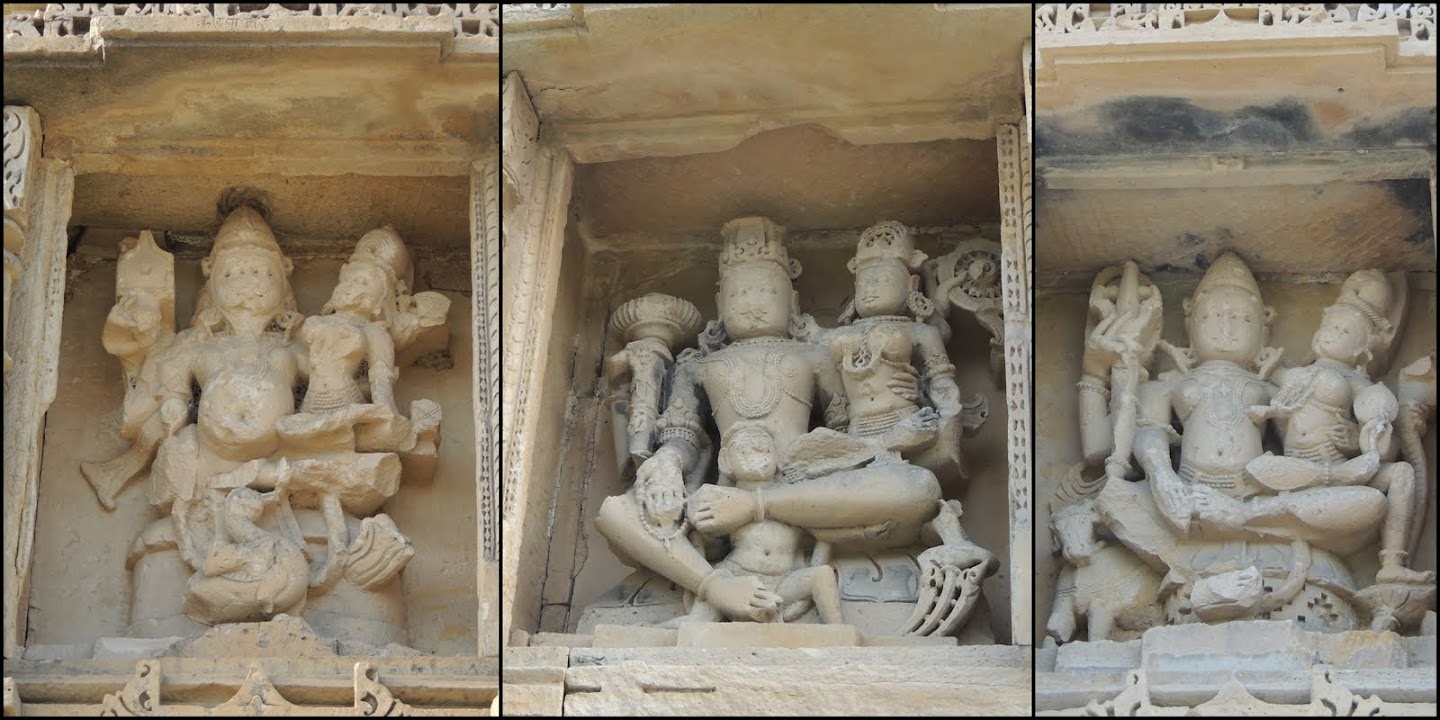 |
| Brahma, Vishnu and Shiva, shown with their consorts, and their Vahanas, seen in the niches of the smaller Shiva temples |
Shiva is seen as Nataraja on the lintel of the Someshwara
temple, and he is shown in his various victorious forms, with multiple arms, on the
outer niches of the temple. Sadly, these images are broken beyond recognition,
so it is difficult to identify them.
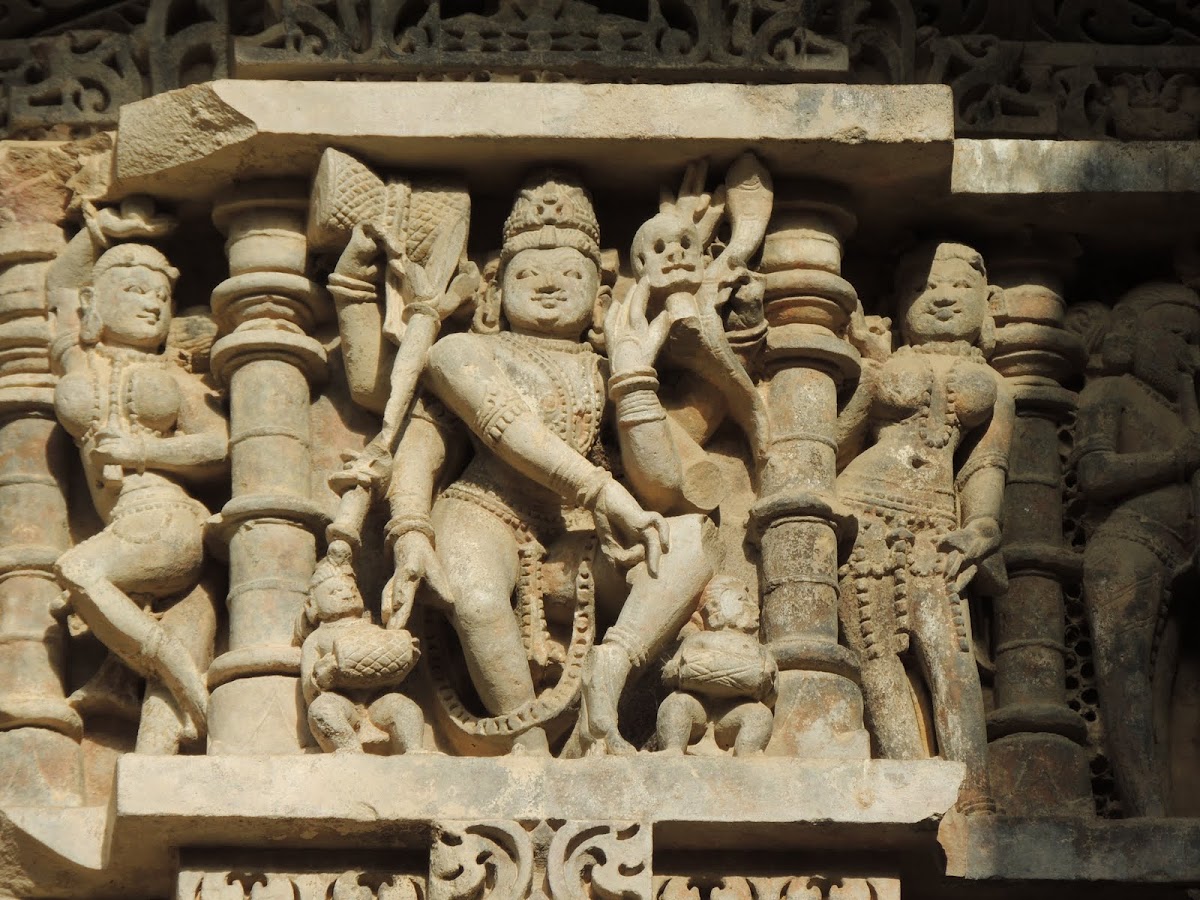 |
| Shiva as Nataraja or Natesa, on the lintel of the Someshwara Temple |
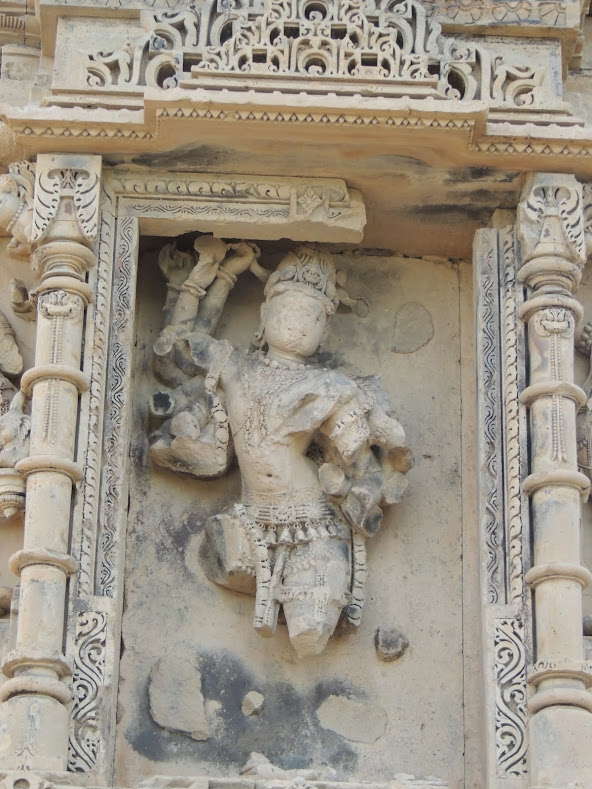 |
| Shiva, probably as Gajantaka, on one of the outer niches of the Someshwara Temple |
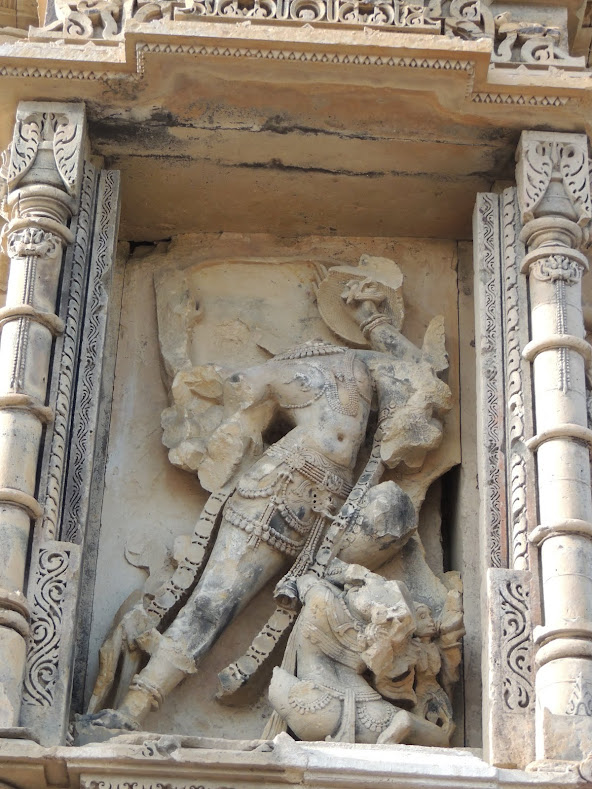 |
| Shiva, probably as Tripurantaka, on one of the outer niches of the Someshwara Temple |
There are also a few composite images, apart from the one of Hari-Hara-Pitamaha-Surya from the lintel of the Someshwara temple that I have already shown you. On the pillars are two unusual composite images, of Ardhanareeshwara and Hari-hara, seen in a seated position!
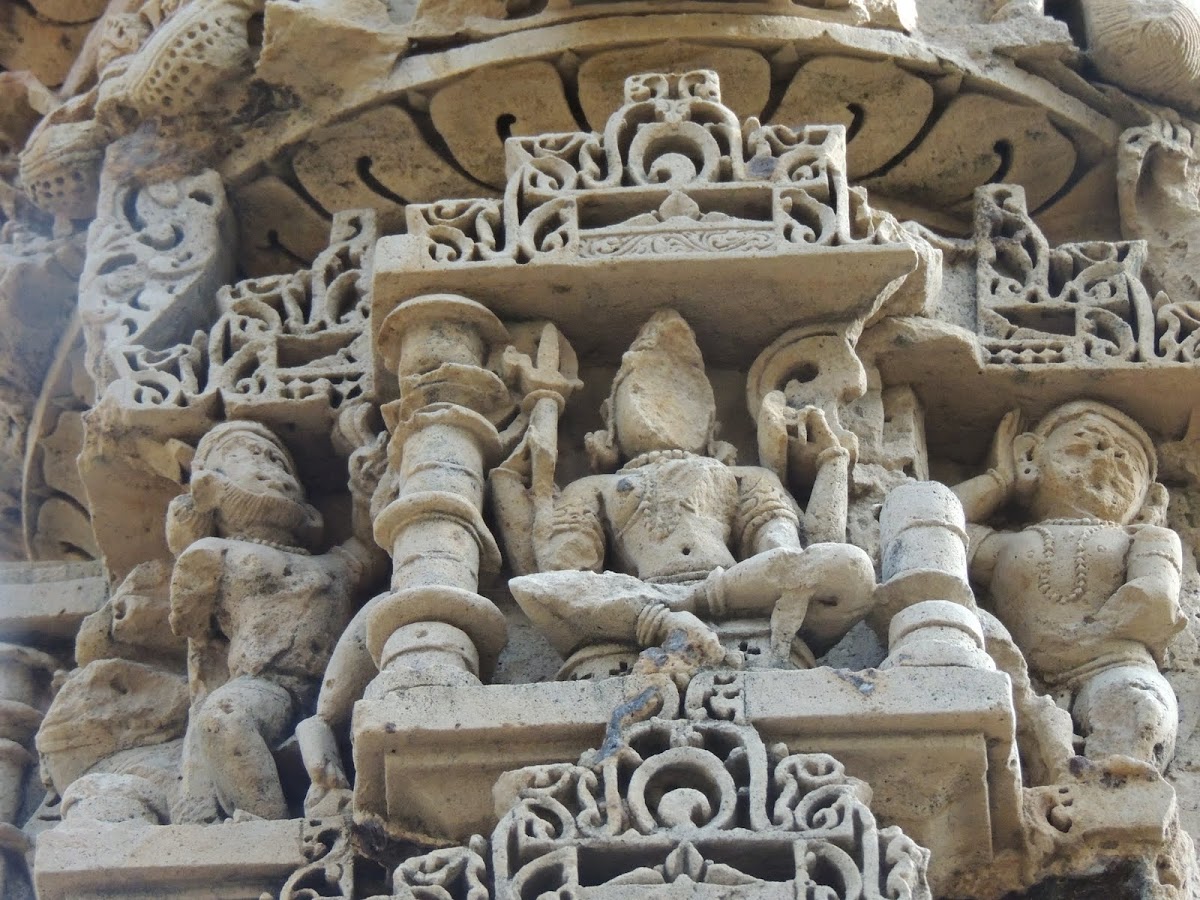 |
| Ardhanareeshwara, with Shiva on the left, holding a trishul, and Parvati on the right, holding a mirror, from one of the pillars of the Someshwara Temple |
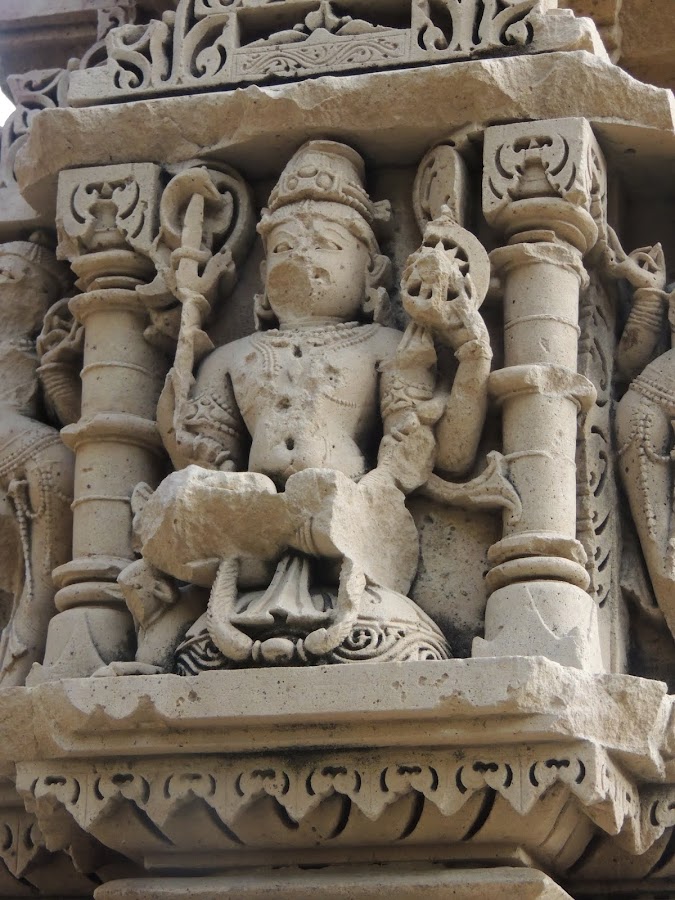 |
| Hari-Hara : On the left side is Shiva, with his Trishul and Nandi by his side, his hair in a jata; on the right side is Vishnu, holding a discus or chakra, wearing a crown. From one of the pillars of the Someshwara Temple |
At the Vishnu temple , only two of the outer niches remain,
and here we see Vishnu in his meditative posture, as well as on Garuda, flanked
by two elephants, which is an unusual depiction.
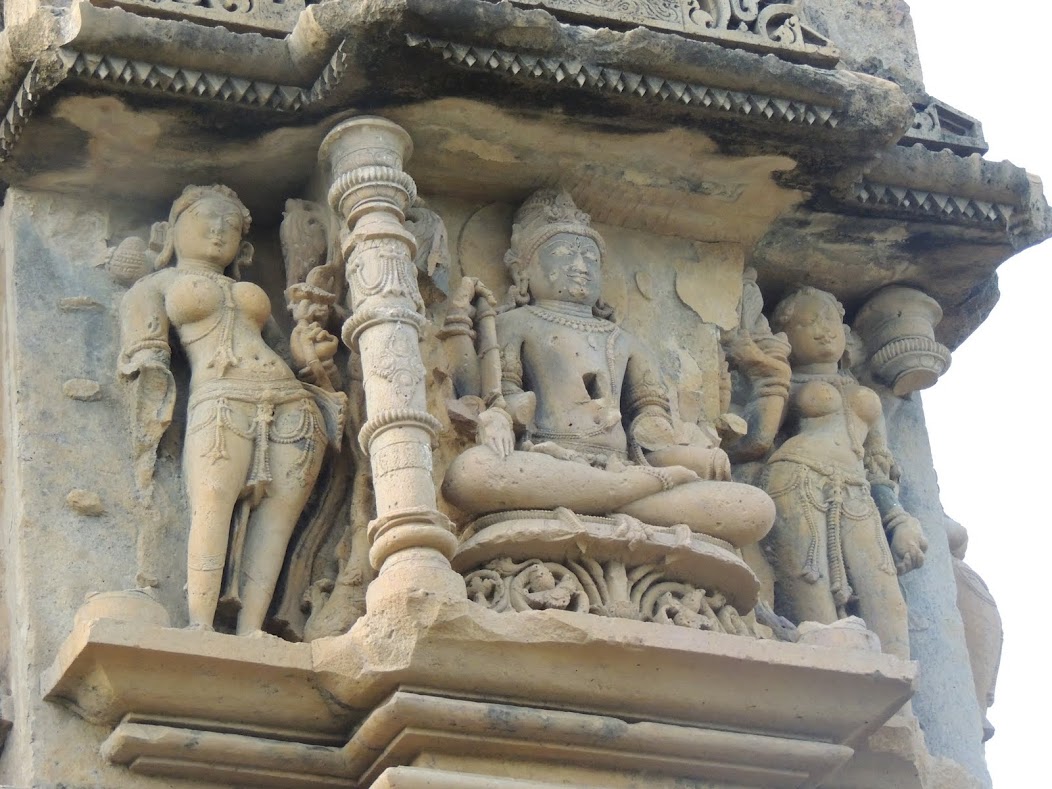 |
| Vishnu, seated in Yogic posture... Yoga Narayana, on the outer wall of the Vishnu Temple |
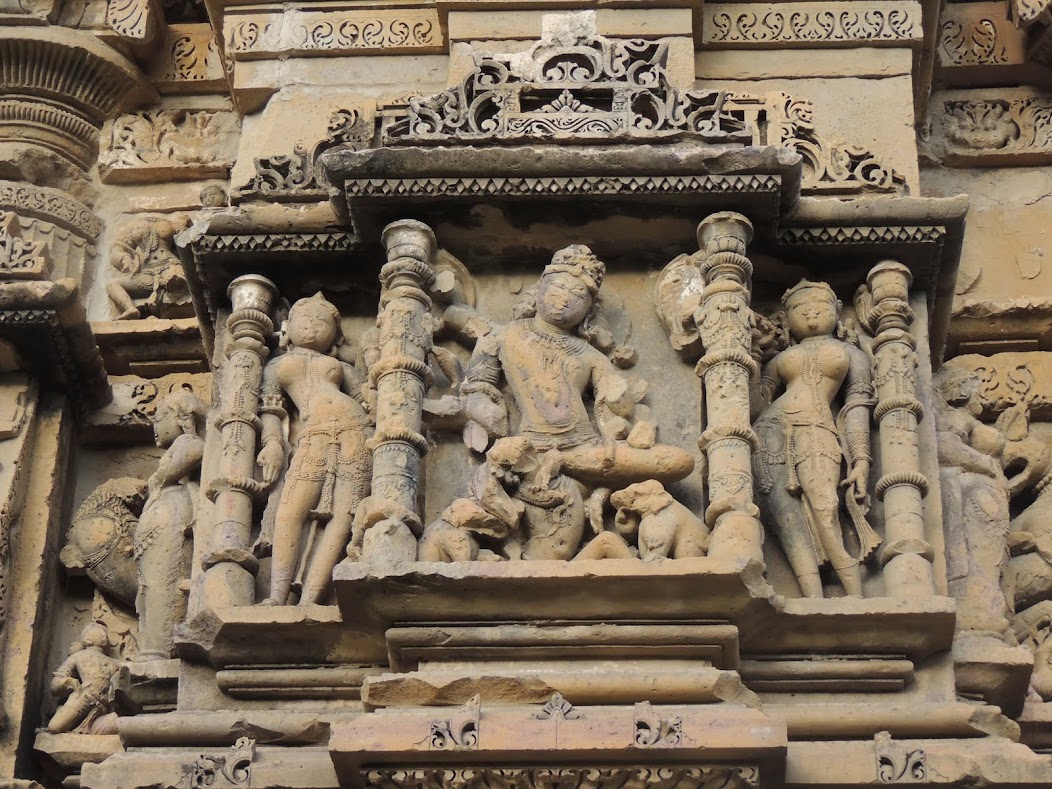 |
| Vishnu, seated on Garuda, on the outer wall of the Vishnu Temple. Look closer and you can see two heads on the side, so this is probably Vaikunta Vishnu. Also, this depiction with two elephants by his side is unusual |
At the Someshwara temple, among the figures on the pillars, I noticed
two of Vishnu – one as Vamana, the
dwarf, and another, which appears to be Buddha.
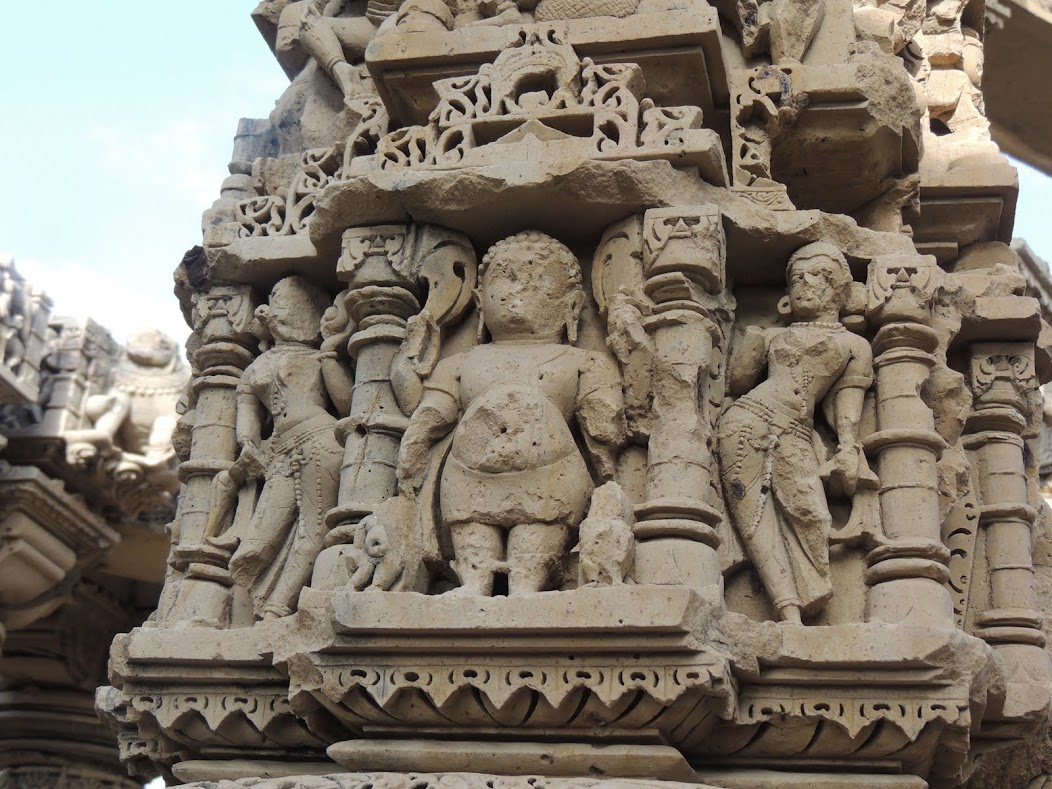 |
| Vishnu as the Dwarf - Vamana, on a pillar of the Someshwara Temple. |
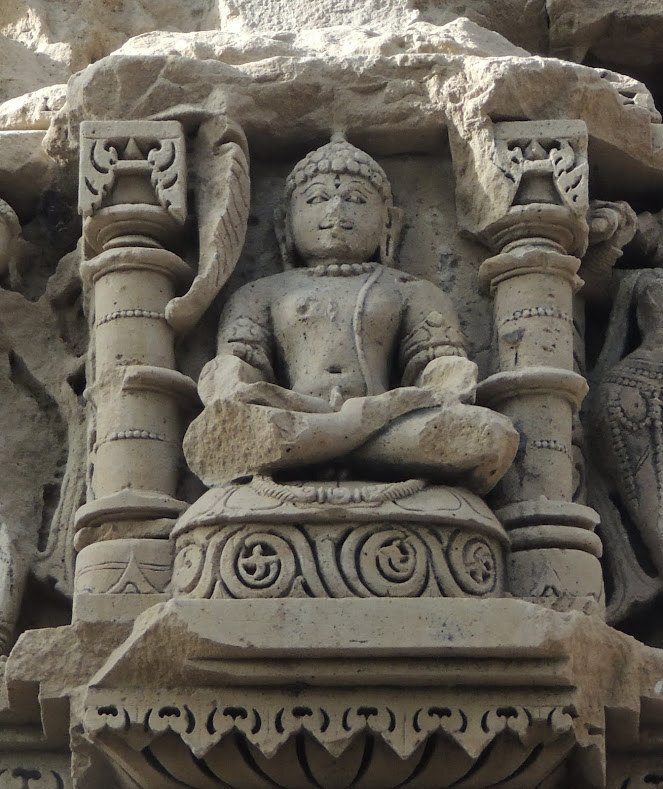 |
| This figure has an uncanny resemblance to Buddha, doesn't it? It is an unusual depiction on the pillar of the Someshwara Temple, and made me wonder if Buddha had already been assimilated into the Dashavatar by the time this temple was built! |
However, I looked in vain for other images of the Dashavatar. Did
they exist, and were they destroyed? Or were they never carved? I suppose we
shall never know. And therein lies the biggest difference between Kiradu and
Khajuraho – that we know so little of those who built these temples, and their beliefs.
However, there is a similarity – in that this must have been,
just like Khajuraho, a place where the royal family, and perhaps, others too,
built temples, for religious merit. The deliberate destruction wreaked upon
these temples also hints at how important the place must have been, both,
socially and politically, during the period.
As we made our way back, past the piles of carved stones which
lie all around, spotting more peacocks posing for us, the guard at the gate kept calling us, asking us to hurry,
since it was time for him to go back home. No one stays here after sunset, not
even the guard, thanks to old legends of a curse.
Sunil told us one version of the curse, and the guard another. The
story essentially was the same – of the villagers here who neglected a young
disciple of a sage. The poor boy went hungry, except when a potter’s wife took
pity on him and fed him. The sage returned to find the boy in a pitiable
condition, and cursed the whole village to be ruined. He of course, warned the
potter’s wife to leave, but she gave in to curiosity, and stopped for a final
look, and was turned to stone!
By the time the guard finished telling us the story, he was so
enthusiastic, that he guided us some way down the road to a clearing, where,
buried in the sand, was part of a stone… with a figure on a horse. It was a
hero stone, which the locals believe is the potter’s wife!
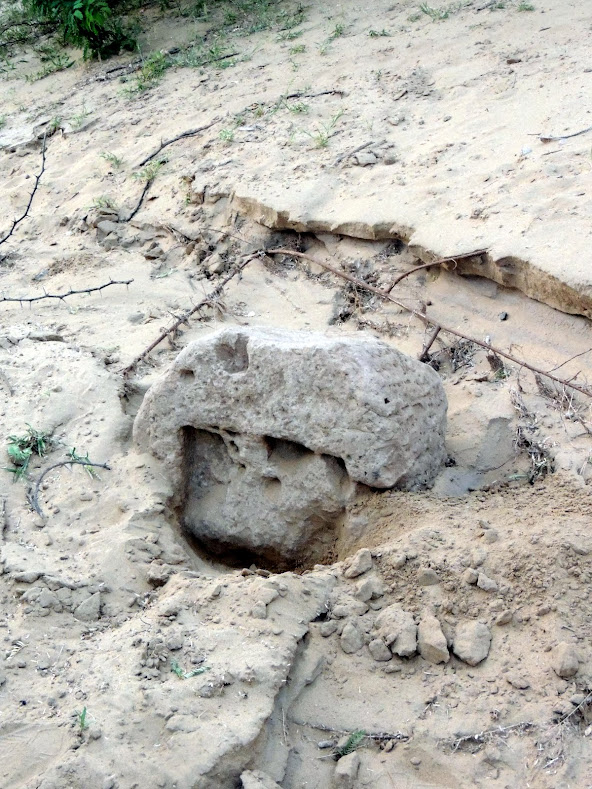 |
A hero stone lies partially buried in the sand by the side of the road.
Locals believe it is the potter's wife, turned to stone! |
A short distance away, also partly buried in the sand, outside
a row of shops, is another stone – a Govardhan, which is some sort of marker, with
Ganesha depicted along with other deities on its four faces.
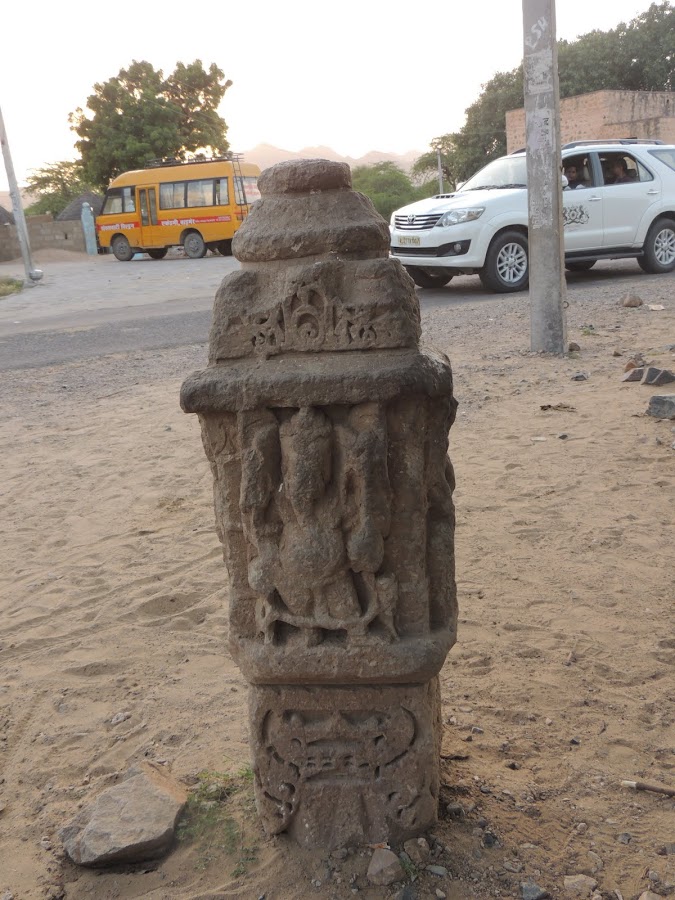 |
| A Goverdhan, some sort of marker, by the side of the road |
As we drove away, watching the last rays of the sun disappear
behind the mountains, I wondered how many more such stones lay buried under the
sands. How wonderful it would be, if we could hear the stories these stones
could tell us, of those who lived here, when these temples must have been
bustling with priests, pilgrims and kings!
That was almost three months ago. However, as I sit today,
writing this post, there are two images which keep coming back – one of my
husband and son standing at the entrance of the Someshwara Temple, intently
looking at an inscription on the wall, trying to decipher it, and, when they
couldn’t read it, trying to imagine what it said; and another of my son,
sitting on a stone in the Vishnu temple, imagining himself as a king, watching
a dance performance in the octagonal mandapa. Much as I enjoy wandering around
temples, trying to understand them, and those who built them through the iconography,
these two images are strangely satisfying memories, for they reassure me that I
have passed on the love of these ancient sites to my son, who looks at them,
not through the lens of history, legend or myth, but through imagination,
which, after all, is just as potent!
A very special Thank You to
Suryagarh, for hosting us and
giving me the opportunity to visit these amazing temples, along with my family.
To read more about Kiradu, head over to
Sudha’s post on the temples. Sudha visited the temples about a month before me, and since I returned, we have
been having a grand time exchanging photos till late into the night, trying to
understand more about the images and the temples. This process has been just as
much fun as visiting the temples! Having said that, we have also realized that
the two of us have seen completely different aspects of the temples - for example, we seem to have noticed completely different sculptures - and would
someday love to go back… together.
Disclaimer:
I visited the temples of Kiradu in September 2016
on an invite by Suryagarh, who ensured that our long trip from Jaisalmer to Kiradu
and back, was comfortable, and added their own special touches to make the
journey memorable. Needless to say, while the experience was courtesy
Suryagarh, the words are all my own!
Pictures are very good and content is great thanks
ReplyDeleteThank you, Rahul.
DeleteSuch lovely temples with gorgeous architecture. Glad to know more about these temples.
ReplyDeleteThank you Niranjan. They are way more beautiful than I can describe! there is so much more to see!
DeleteIt is always fascinating to read your descriptions of these temples. The intricacy of the carving on the temples is amazing, even with so much of it damaged. Thanks for another great posting, Anu!
ReplyDeleteThank you so much, Natalie! It feels so good to read your comments. As for the temples, they are just amazing. And there is so much more... much as it is hard to believe, this is just a fraction of the work here!
DeleteIt is the temples like these which take you back in time, where you feel Ohh Wow Such Majestic Rich Curved Temples : the level of dedication of Storytelling was so Strong and Rustic ! Years and Years down still they Stand Still ! Loved the Post every Pillar has some story to say be it on the Sand or Under the Sand !
ReplyDeleteYes, Pooja. Temples like these do take us back in time, but only if we listen and pay attention to the stories they can tell us.
DeleteThanks for sharing great, inspirational and very informative travel story. Love all the above temple pics.
ReplyDeleteThank you Devesh!
Delete